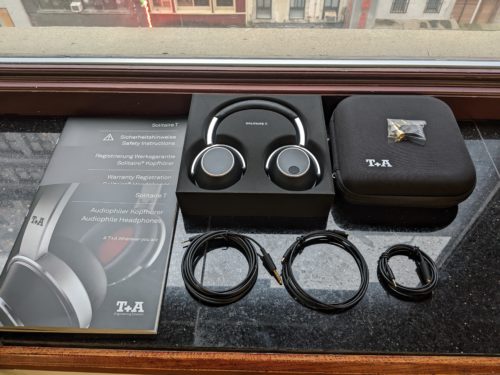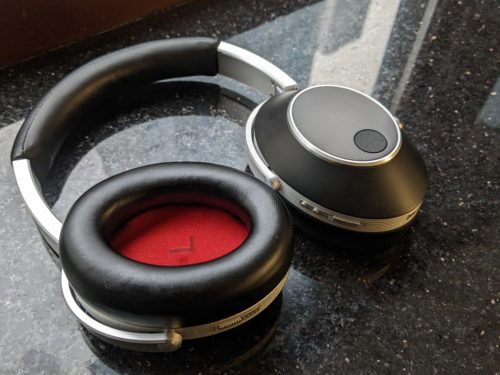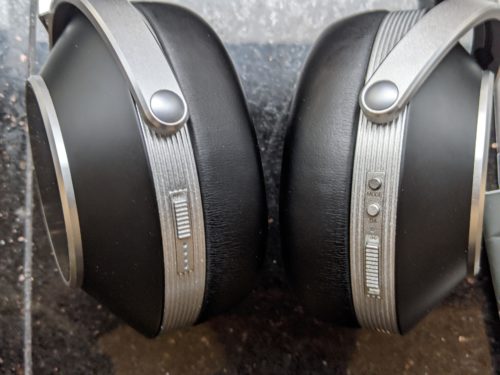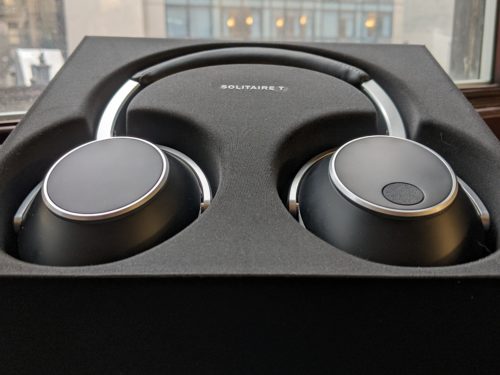T+A Solitaire T Review
If you’re only somewhat familiar with T+A, it’s likely that you know them as that intimidating German audiophile company that released a $6,900 Planar-Magnetostatic headphone (the Solitaire P). For a little while, the only headphone offerings from the company were the $6,900 Solitaire P or its somewhat less expensive little sibling, the Solitaire P-SE. Now, the company has added a new over-ear, ANC true wireless headphone to its exclusive catalog: the T+A Solitaire T. Frankly, I’m intrigued by a wireless headphone that sports a $1,600 price tag, and hope it can walk the walk. We’ll be going over some of the tech, specs, and finally, what the T+A Solitaire T sounds like.

What’s In The Box?
- T+A Solitaire P True Wireless ANC Over-Ear Headphones
- Firm Carrying Case
- Headphone Cable with 3.5mm Unbalanced Jack
- Headphone Cable with 4.4mm Balanced Jack
- USBC Cable
- 3.5mm to 6.35mm Headphone Jack Adapter
- Airplane Adapter
- Manual
- Safety Instructions
- Warranty

Look and Feel
My only minor complaint with the Solitaire T’s fit is the small cups that may result in something closer to an on-ear fit for those with larger ears. Though I have smaller ears that didn’t give me this problem, the otherwise soft and comfortable leather pads provide minimal ventilation and had my ears heating up a bit over the course of an extended listen. Aside from that, the Solitaire T has a pretty average weight of 326 grams, and a headband padded with the same high quality leather found on the earpadding. Headband pressure seemed just right, and kept the headphones secured on my head without crushing down on my skull. The sliders and cans are sturdy and metallic, and can rotate 180 degrees for an easy around-the-neck fit.
The metal in the build is the dominant feature in terms of style. It comes across as serious, neutral, and inconspicuous. Not that I necessarily recommend walking around carelessly with a pair of $1600 headphones on your head, but I have to admit, the Solitaire T would make it pretty to do without drawing too much attention.

Bluetooth, Noise Cancellation, Battery, Technical Specs
At 70 hours, the T+A Solitaire T has the longest battery life of any wireless over-ear on the market, dethroning the Sennheiser Momentum 4’s 60 hour battery life. A “High Quality” mode cuts the battery life in half when in use, but utilizes a built in Quad SABRE HiFi DAC to drive the headphone’s tranducers. Damping is positioned next to the transducers to eliminate coil reflections before they develop, which leads to a clean and tightly controlled frequency response. Bass matching is achieved through an optimized low bass system. This is simply an exceptional amount of design effort to see in a wireless release.
I found the ANC mode to be right about on par with this year’s generation of wireless releases. When active, the deep roar of the central air unit that I sit next to was reduced to a minimal hum. Transparency mode was pretty great and very realistic, devoid of the harsh tone you might hear on other wireless headphones, and expressed environmental sounds at just the right volume relative to the music I was listening to.
Frequency Response: 4 Hz – 22 kHz
Driver: Dynamic
Battery Life: 70 Hours, 35 Hours in High Quality Mode
Charging Time: 2 Hours
Bluetooth: 5.1
Codecs: AAC, SBC, aptX, aptX HD
Microphones: 2 for voice on the right, 2 for ANC either side
Modes: ANC on, ANC off, High Quality mode (ANC is off)
Smart Controls
- 1 tap: Pause/Play
- Swipe Up/Down: Volume Up/Down
- Swipe Forward/Back: Next Track/Last Track
- Transparency touch sensitive button to toggle transparency mode on and off.
Sound Impressions of Different Connections
I’ll be writing in depth about the wireless balance and sound stage for the rest of the review, but here are some of my impressions on the wired connections:
- Balanced 4.4mm via iBasso DC06 DAC: Low end is tighter and more defined. Sound stage by and large unchanged.
- USBC Connection to my Pixel 3A Phone: Sound stage seems wider, more fluid and engaging. Unfortunately extremely quiet even with my phone on max volume. If you have a DAC/Amp with a USBC output, go for it; if this headphone were mine, however, I would be perfectly content with the 4.4mm and wireless connections.
Sound Stage
From here on out, I’ll be judging the T+A Solitaire T on its wireless sound quality. My first impression of the imaging and staging was that it seems very similar to the Bowers & Wilkins PX8. While fluid and convincing, it’s fairly small and insulated, sticking mostly to left-right linearity with pans that produce a sensation across my face. The wide pans through out the album Dejavu by Matty were produced realistically, but didn’t have the 360 degree, around-the-back-of-the-head spinning sensation they elicit on wired headphones with exceptional soundstages. High Quality mode didn’t appear to effect stage very much – but made quite a difference in the balance, which is certainly the Solitaire T’s most compelling quality. Its imaging and staging was perfectly adequate, but mostly left me with a neutral impression.
Lows
T+A’s Solitaire T is finally, finally, a wireless headphone that doesn’t have any traces of the typical soft and smoothed over wireless balance. Low end comes across refreshingly well balanced and very tastefully boosted, sitting naturally in the overall EQ. Subs are moderately present and felt on the right kick drums and basses, while low-mid bass does most of the driving and heavy lifting. High Quality mode subtly but noticeably amplified and solidified the low end, specifically improving sub volume and definition. As far as I’m concerned, this is a well controlled, Goldilocks bass balance that doesn’t mask and muddy mixes, but rumbles and booms just enough to provide that physically-felt low end satisfaction.
Mids
I almost can’t believe I’m saying this considering the relative norm surrounding wireless balances, but the Solitaire T actually seems to have a mids balance that favors center and high mids after cooling down from its slightly boosted low end. No overemphasized low mids this time: vocals sounded crisp, finding a realistic balance between their low-mid fundamentals and crispy, center-to-upper-mid fry. Guitars actually had twang and drive instead of awkward boosts on their low end hum. Snare drums struck a great balance of low mid body and high mid crack. Though low mids seemed to creep up a bit in noise cancelling mode, I can’t say it was very significant, and it wasn’t of much detriment to sound quality. The Solitaire T’s mid balance is arguably its most stand out quality that sets it apart from other wireless headphones.
Highs
It’s here that I found High Quality mode to make the greatest difference. In ANC and passive mode, high frequencies were fully present with a fairly standard roll off, but could at times sound a little shrill around the notoriously tricky 4 kHz region. High Quality mode mostly smoothed out this minor issue with shrillness, and also seemed to expand high end range. The needling, almost unintelligibly high frequencies in “People Are Friends” by Biosphere were noticeably louder and more articulate with HQ mode flipped on. Cymbals rang out with harmonic detail, hi-hats sounded natural and sharp, and synths saw an adequate expression of their buzzy overtones. Vocals were permitted their airy qualities and the details in reverb tails were perfectly apparent. While HQ mode produces the ideal highs balance for the Solitaire T, I was fairly impressed with the definition and depth of the highs in ANC and passive modes as well.

Overall
The T+A Solitaire has the best balance of any wireless ANC Bluetooth headphone at the time of writing this article. This is perhaps the first time I could truly forget that I was listening with a Bluetooth headphone. Why am I not giving this a Major HiFi Gold? The price and the sound stage. Why not a silver? The price. While this may be the most impressive wireless headphone I’ve reviewed, I have to admit that its hard to be okay with it going for twice as much as the Focal Bathys (which happens to beat out the Solitaire T in terms of sound stage). A price drop of a few hundred dollars would make the T+A Solitaire the best wireless headphone of the year. Honestly, I still think it is, and hope the future holds more wireless balances like the Solitaire T’s at more affordable prices.
The Solitaire T can be purchased here from Audio46.
| Pros | Cons |
| Variety of wired and wireless connections available
70 hour battery life Easy Bluetooth pairing with a strong connection Forceful low end that doesn’t overshadow the rest of the balance Balanced and clear mids profile, vocals sound great Realistic and revealing highs High Quality mode |
Price
Small earpads that can get hot Narrow sound stage Very quiet via USBC connection
|
MAJORHIFI may receive commissions from retail offers.







